1.初中英语八大时态总结
初中英语八大时态总结

初中英语八大时态总结英语时态是英语的一个重要部分,时态使用正确与否,直接影响着句子的准确表达。
初中阶段的学生应该掌握八大基本时态,包括:1. 一般现在时(Simple Present):表示经常性的、习惯性的动作或存在的状态。
结构:主语 + 动词原形 / 动词第三人称单数形式(s或es)例如:I go to school every day.(我每天上学。
)He likes playing football.(他喜欢踢足球。
)2. 一般过去时(Simple Past):表示过去发生的动作或存在的状态。
结构:主语+动词过去式例如:She walked to the park yesterday.(昨天她走到公园。
)3. 一般将来时(Simple Future):表示将来会发生的动作或存在的状态。
结构:主语 + will / shall + 动词原形例如:We will go camping next weekend.(我们下周末去野营。
)4. 现在进行时(Present Continuous):表示正在进行的动作。
结构:主语 + am / is / are + 现在分词(动词-ing形式)例如:They are watching TV now.(他们现在正在看电视。
)5. 过去进行时(Past Continuous):表示过去其中一时间正在进行的动作。
结构:主语 + was / were + 现在分词6. 将来进行时(Future Continuous):表示将来其中一时间将要进行的动作。
结构:主语 + will be + 现在分词7. 现在完成时(Present Perfect):表示过去的其中一时间开始,一直延续到现在的动作或状态。
结构:主语 + have / has + 过去分词例如:We have lived here for ten years.(我们在这里已经住了十年。
)8. 过去完成时(Past Perfect):表示过去其中一时间点之前发生的动作。
初中英语语法八大时态总结
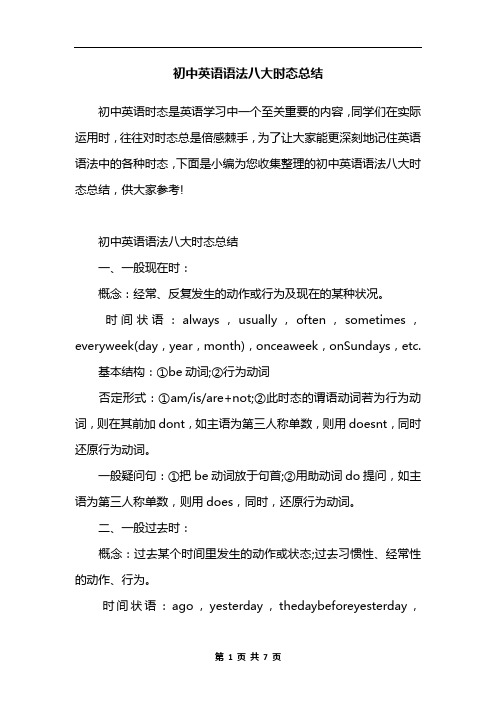
初中英语语法八大时态总结初中英语时态是英语学习中一个至关重要的内容,同学们在实际运用时,往往对时态总是倍感棘手,为了让大家能更深刻地记住英语语法中的各种时态,下面是小编为您收集整理的初中英语语法八大时态总结,供大家参考!初中英语语法八大时态总结一、一般现在时:概念:经常、反复发生的动作或行为及现在的某种状况。
时间状语:always,usually,often,sometimes,everyweek(day,year,month),onceaweek,onSundays,etc.基本结构:①be动词;②行为动词否定形式:①am/is/are+not;②此时态的谓语动词若为行为动词,则在其前加dont,如主语为第三人称单数,则用doesnt,同时还原行为动词。
一般疑问句:①把be动词放于句首;②用助动词do提问,如主语为第三人称单数,则用does,同时,还原行为动词。
二、一般过去时:概念:过去某个时间里发生的动作或状态;过去习惯性、经常性的动作、行为。
时间状语:ago,yesterday,thedaybeforeyesterday,lastweek(year,night,month),in1989,justnow,attheageof5,oneday,longlongago,onceuponatime,etc.基本结构:①be动词;②行为动词否定形式:①was/were+not;②在行为动词前加didnt,同时还原行为动词。
一般疑问句:①was或were放于句首;②用助动词do的过去式did提问,同时还原行为动词。
三、现在进行时:概念:表示现阶段或说话时正在进行的动作及行为。
时间状语:now,atthistime,thesedays,etc.基本结构:am/is/are+doing否定形式:am/is/are+not+doing.一般疑问句:把be动词放于句首。
四、过去进行时:概念:表示过去某段时间或某一时刻正在发生或进行的行为或动作。
初中英语八种基本时态总结

初中英语八种基本时态总结1、概念:1)表示过去某个时间发生的动作或存在的状态。
例:I went to the park yesterday.He was sick last week.2)表示过去的惯性动作,常与表示频度的时间状语连用,但要用过去式的时间状语。
例:I used to play basketball every day after school.3)表示过去的客观真理或科学事实。
例:Newton discovered the law of gravity in 1687.4)表示过去的虚拟语气。
例:If I had known the truth。
I would have told you.2、结构:表状态S+was/were+P表动作S+V过去式+O3、句式变化:变疑问,把was/were提到主语前。
变否定,在was/were后加“not”。
例:①I visited my grandparents last weekend。
→Did you visit your grandparents last weekend。
Yes。
I did。
/ No。
I didn’t。
→I didn’t visit my grandparents last weekend.②She was happy to see her old friend。
→Was she happy to see her old friend。
Yes。
she was。
/ No。
she wasn’t。
→She wasn’t happy to see her old friend.No。
I'm not。
→ I'm not writing a letter now.②They are watching TV at this time。
→ Are they watching TV at this time。
Yes。
they are。
初中八大时态总结
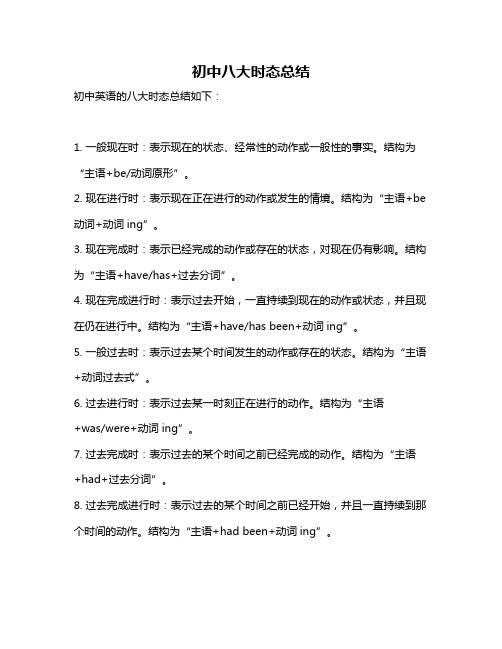
初中八大时态总结
初中英语的八大时态总结如下:
1. 一般现在时:表示现在的状态、经常性的动作或一般性的事实。
结构为“主语+be/动词原形”。
2. 现在进行时:表示现在正在进行的动作或发生的情境。
结构为“主语+be 动词+动词ing”。
3. 现在完成时:表示已经完成的动作或存在的状态,对现在仍有影响。
结构为“主语+have/has+过去分词”。
4. 现在完成进行时:表示过去开始,一直持续到现在的动作或状态,并且现在仍在进行中。
结构为“主语+have/has been+动词ing”。
5. 一般过去时:表示过去某个时间发生的动作或存在的状态。
结构为“主语+动词过去式”。
6. 过去进行时:表示过去某一时刻正在进行的动作。
结构为“主语
+was/were+动词ing”。
7. 过去完成时:表示过去的某个时间之前已经完成的动作。
结构为“主语+had+过去分词”。
8. 过去完成进行时:表示过去的某个时间之前已经开始,并且一直持续到那个时间的动作。
结构为“主语+had been+动词ing”。
以上是初中英语八大时态的总结,希望对你有所帮助。
【初中】英语八大时态详细汇总

现在完成时意义:He has lived here for many years.2.强调后果/影响I have read the book .结构:时间状语:(1)since 的用法Since+时间点I have lived here since 2022.一段时间+ago I have lived here since two years ago.+从句(用一般过去时)常见句型:It is + 一段时间+since从句主句(完成时)+since(一般过去时)It is seven years since I met him last time.He has learned 2000 words since he went to school.(2)For+时间段We have known each other for five years.(3)already(用于肯定句中)/yet (用与否定句或疑问句中)just/everrecently( in recent years)before never等(just now是一般过去时的时间状语)I have just finished my homework.Have you ever seen one like this?(4So far /in the past few years等,表示:“目前为止”非延续性动词延续性动词非延续性动词延续性动词Borrow Keep Fall asleep Be asleep buy have Catch a cold Have a cold leave Be away Begin/start Be ondie Be dead open Be open Come (to)Be in/at close Be closed区分Have gone to去了没回Have been to去了回来(常与次数once/twice/基数词+times连用)Have been in在某地呆了多久例句:(1)You can’t see her because he has gone to Sibo.(2)He has been to Sibo twice.(3)He has been in this city for two years.备注:Here/there/home 不与介词连用。
初中英语必考的“八大时态”用法总结

初中英语必考的“八大时态”用法总结“时态”无疑是学习英语时最重要的语法内容,学好时态基本就拿下了语法的半壁江山。
今天总结了初中英语必考的“八种时态”必学、必考,一定要加倍重视!英语八大时态一、一般现在时do/does;is/am/are①表示现在的情况、状态或特征。
例:He is a student.他是一个学生。
②表示经常性、习惯性动作。
例:He always helps others.他总是帮助别人。
③客观事实和普遍真理。
例:The earth moves the sun.地球绕着太阳转。
④表示一个按规定、计划或安排要发生的动作。
仅限于某些表示“来、去、动、停、开始、结束、继续”等的动词,可以与表示未来时间的状语搭配使用。
常见的用法是:飞机、火车、轮船、汽车等定期定点运行的交通方式。
例:The next train leaves at 3 o'clock this afternoon.下一趟火车今天下午3点开车。
⑤在时间、条件和让步状语从句中经常用一般现在(有时也用现在完成时)表示将来事情。
(即:主将从现原则)例:I will call you as soon as I arrive at the airport.我一到机场就会给你打电话。
When you have finished the report,I will have waited for about 3 hours.等你完成这份报告的时候,我就已经等了将近3个小时了。
一般过去时①表示过去某个时间发生的动作或情况。
例:I bought some fruits yesterday.我昨天买了一些水果。
②表示过去习惯性动作。
例:When I was a boy,I often swamin that river.would/used to do:表示过去常常......例:The old man would sit on a bench in the quiet park and look at others for hours without doing anything or talking to anybody.老人过去常常坐在宁静的公园里的一条长椅上,看着其他的人,一坐就是数个小时,什么也不干,也不和任何人交谈。
初中英语8大时态

Was I/ he/ she/ it working?
I/ He/ She/ It Was I /he/ she /it
was not working.not working?或 或I/ he/ she/ it Wasn’t I/ he/ she wasn’t working./it working?
时间状语: always, usually, often, sometimes, every week (day, year, month…), once a week,
否定形式: ①am/is/are+not; ②谓语动词为行为动词,则在其前加don't, 如主语为第三人称单数,则用doesn't,加 动词原型。
e.g.We won’t go to the park if it rains tomorrow. 如果明天下雨,我们将不去公园。
When I grow up, I will go to America. 我长大后要去美国。
动词第三人称单数 形式变化规则
规则
例子
一般在词尾加-s,(清辅音 后读/s/,在浊辅音后读 /z/;在t后读/ts/,在d后读 /dz/。)
We/ You/ They
were teachers.
Were we/ We/ You/ They Were we/ you/ they not
you/ they were not/
teachers?或Weren’t we/
teachers?weren’t teachers.you/ they teacher?
3.基本结构 主语+was/were +doing +其他 4.否定形式: 主语+was/were + not +doing+其他 5.一般疑问句: 把was或were放于句首。(第 一个字母大写) 其句式变化仍然要在be上做文章。
(完整版)初中英语八大时态总结
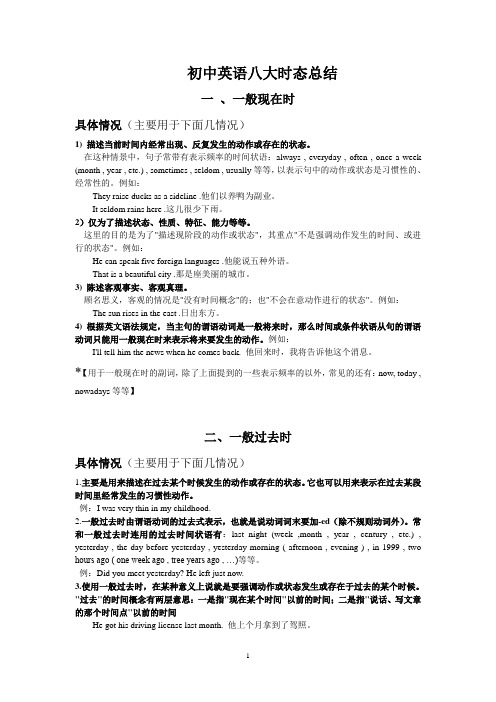
初中英语八大时态总结一、一般现在时具体情况(主要用于下面几情况)1) 描述当前时间内经常出现、反复发生的动作或存在的状态。
在这种情景中,句子常带有表示频率的时间状语:always , everyday , often , once a week (month , year , etc.) , sometimes , seldom , usually等等,以表示句中的动作或状态是习惯性的、经常性的。
例如:They raise ducks as a sideline .他们以养鸭为副业。
It seldom rains here .这儿很少下雨。
2)仅为了描述状态、性质、特征、能力等等。
这里的目的是为了"描述现阶段的动作或状态",其重点"不是强调动作发生的时间、或进行的状态"。
例如:He can speak five foreign languages .他能说五种外语。
That is a beautiful city .那是座美丽的城市。
3) 陈述客观事实、客观真理。
顾名思义,客观的情况是"没有时间概念"的;也"不会在意动作进行的状态"。
例如:The sun rises in the east .日出东方。
4) 根据英文语法规定,当主句的谓语动词是一般将来时,那么时间或条件状语从句的谓语动词只能用一般现在时来表示将来要发生的动作。
例如:I'll tell him the news when he comes back. 他回来时,我将告诉他这个消息。
*【用于一般现在时的副词,除了上面提到的一些表示频率的以外,常见的还有:now, today , nowadays等等】二、一般过去时具体情况(主要用于下面几情况)1.主要是用来描述在过去某个时候发生的动作或存在的状态。
它也可以用来表示在过去某段时间里经常发生的习惯性动作。
初中英语语法八大时态总结完整版
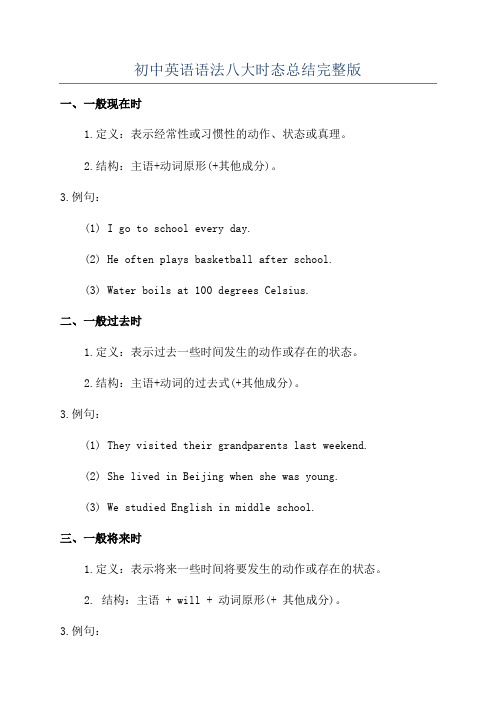
初中英语语法八大时态总结完整版一、一般现在时1.定义:表示经常性或习惯性的动作、状态或真理。
2.结构:主语+动词原形(+其他成分)。
3.例句:(1) I go to school every day.(2) He often plays basketball after school.(3) Water boils at 100 degrees Celsius.二、一般过去时1.定义:表示过去一些时间发生的动作或存在的状态。
2.结构:主语+动词的过去式(+其他成分)。
3.例句:(1) They visited their grandparents last weekend.(2) She lived in Beijing when she was young.(3) We studied English in middle school.三、一般将来时1.定义:表示将来一些时间将要发生的动作或存在的状态。
2. 结构:主语 + will + 动词原形(+ 其他成分)。
3.例句:(1) I will go to the park tomorrow.(3) We will have a party next week.四、现在进行时1.定义:表示现在正在进行的动作。
2. 结构:主语 + am/is/are + 动词-ing(+ 其他成分)。
3.例句:(1) She is reading a book right now.(2) They are playing soccer in the park.(3) We are having dinner at the moment.五、过去进行时1.定义:表示过去一些时间正在进行的动作。
2. 结构:主语 + was/were + 动词-ing(+ 其他成分)。
3.例句:(1) He was watching TV at 8 o'clock last night.(2) They were traveling in Europe during summer vacation.(3) We were studying when the phone rang.六、将来进行时1.定义:表示将来一些时间正在进行的动作。
初中英语语法八大时态总结(完整版)
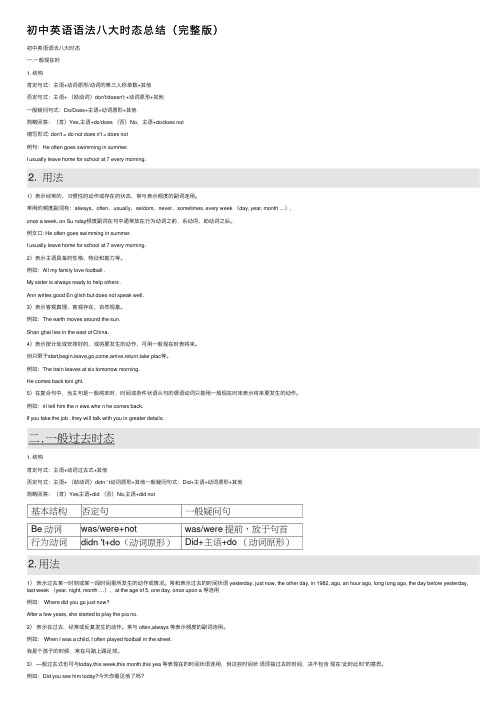
初中英语语法⼋⼤时态总结(完整版)初中英语语法⼋⼤时态⼀.⼀般现在时1. 结构肯定句式:主语+动词原形/动词的第三⼈称单数+其他否定句式:主语+ (助动词)don't/doesn't +动词原形+其他⼀般疑问句式:Do/Does+主语+动词原形+其他简略回答:(肯)Yes,主语+do/does (否)No,主语+do/does not缩写形式: don't = do not does n't = does not例句:He often goes swimming in summer.I usually leave home for school at 7 every morning.1)表⽰经常的、习惯性的动作或存在的状态,常与表⽰频度的副词连⽤。
常⽤的频度副词有:always、often、usually、seldom、never、sometimes, every week (day, year, month …),once a week, on Su nday频度副词在句中通常放在⾏为动词之前,系动词、助动词之后。
例⼥⼝: He often goes swimming in summer.I usually leave home for school at 7 every morning.2)表⽰主语具备的性格、特征和能⼒等。
例如:All my family love football .My sister is always ready to help others .Ann writes good En glish but does not speak well.3)表⽰客观真理、客观存在、⾃然现象。
例如:The earth moves around the sun.Shan ghai lies in the east of China.4)表⽰按计划或安排好的,或将要发⽣的动作,可⽤⼀般现在时表将来。
初中英语语法八大时态总结完整版初中英语时态总结
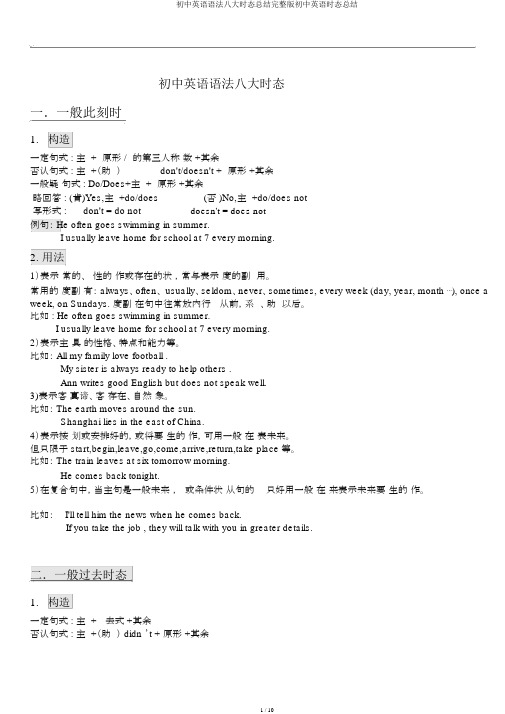
初中英语语法八大时态总结完整版初中英语时态总结初中英语语法八大时态一.一般此刻时1.构造一定句式 : 主 +原形 /的第三人称数 +其余否认句式 : 主 +(助)don't/doesn't +原形 +其余一般疑句式 : Do/Does+主 +原形 +其余略回答 : (肯)Yes,主 +do/does(否 )No,主 +do/does not写形式 : don't = do not doesn't = does not例句: He often goes swimming in summer.I usually leave home for school at 7 every morning.2.用法1)表示常的、性的作或存在的状,常与表示度的副用。
常用的度副有: always、often、 usually、seldom、never、sometimes, every week (day, year, month ⋯), once a week, on Sundays. 度副在句中往常放内行从前,系、助以后。
比如 : He often goes swimming in summer.I usually leave home for school at 7 every morning.2)表示主具的性格、特点和能力等。
比如: All my family love football .My sister is always ready to help others .Ann writes good English but does not speak well.3)表示客真谛、客存在、自然象。
比如: The earth moves around the sun.Shanghai lies in the east of China.4)表示按划或安排好的,或将要生的作,可用一般在表未来。
初中英语的八大时态

初中英语的八大时态时态无疑是学校英语最重要的语法内容,学好时态基本就拿下了语法的半壁江山。
,我在这里整理了学校英语的八大时态,盼望能关心到大家。
一般现在时一1. 概念:常常、反复发生的动作或行为及现在的某种状况。
2. 基本结构:①is/am/are;②do/does否定形式:①am/is/are+not;②此时态的谓语动词若为行为动词,则在其前加dont,如主语为第三人称单数,则用doesnt,同时还原行为动词。
3. 一般疑问句:①把is/am/are动词放于句首;②用助动词do 提问,如主语为第三人称单数,则用does,同时,还原行为动词。
4. 用法1) 常常性或习惯性的动作,常与表示频度的时间状语连用。
例如:I leave home for school at 7 every morning. 每天早上我七点离开家。
2) 客观真理,客观存在,科学事实。
例如:The earth moves around the sun. 地球绕太阳转动。
Shanghai lies in the east ofChina. 上海位于中国东部。
3) 表示格言或警句。
例如:Pride goes before a fall. 骄者必败。
留意:此用法假如消失在宾语从句中,即使主句是过去时,从句谓语也要用一般现在时。
例如:Columbus proved that the earth is round. 哥伦布证明了地球是圆的。
4) 现在时刻的状态、力量、性格、共性。
例如:I dont want so much. 我不要那么多。
Ann writes good English but does not speak well.安英语写得不错,讲的可不行。
5) 一般现在时表示将来含义a. 下列动词come, go, arrive, leave, start, begin, return的一般现在时可以表示将来,主要用来表示在时间上已确定或支配好的事情。
初中英语语法八大时态总结
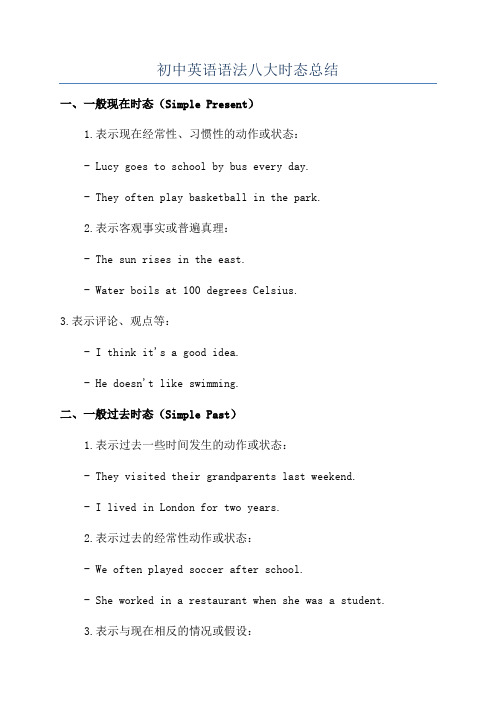
初中英语语法八大时态总结一、一般现在时态(Simple Present)1.表示现在经常性、习惯性的动作或状态:- Lucy goes to school by bus every day.- They often play basketball in the park.2.表示客观事实或普遍真理:- The sun rises in the east.- Water boils at 100 degrees Celsius.3.表示评论、观点等:- I think it's a good idea.- He doesn't like swimming.二、一般过去时态(Simple Past)1.表示过去一些时间发生的动作或状态:- They visited their grandparents last weekend.- I lived in London for two years.2.表示过去的经常性动作或状态:- We often played soccer after school.- She worked in a restaurant when she was a student.3.表示与现在相反的情况或假设:- If I had money, I would buy a new car.- I wish I could go to the concert with you.三、一般将来时态(Simple Future)1.表示将来要发生的事情:- I will meet him at the airport tomorrow.- They are going to have a party next week.2.表示意愿、打算或承诺:- I promise I will help you.- She is going to study abroad next year.四、现在进行时态(Present Continuous)1.表示现在正在进行或暂时的动作:- They are playing football in the park.- He is studying for the exam.2.表示现阶段的变化或趋势:- The population of the city is increasing rapidly.- More and more people are using smartphones.五、过去进行时态(Past Continuous)1.表示过去一些时间正在进行中的动作:- I was watching TV when she called me.- They were having dinner when the power went out.2.表示过去一些时间同时发生的两个动作:- While he was reading, his sister was playing the piano.- When I arrived, they were still waiting for you.六、将来进行时态(Future Continuous)1.表示将来一些时间正在进行的动作:- He will be sleeping when you arrive.2.表示将来一些时间同时发生的两个动作:- While you are washing the dishes, I will be cleaning the bathroom.- When I call you, she will be cooking dinner.七、现在完成时态(Present Perfect)1.表示过去发生但对现在有影响的动作或状态:- I have lost my key, so I can't open the door.- She has finished her homework, so she can watch TV now.2.表示经历或遭遇过的事情:- Have you ever been to Paris?- He has never seen such a beautiful sunset.八、过去完成时态(Past Perfect)1.表示在过去一些时间之前已经发生的动作或状态:- When I arrived, they had already left.2.表示过去一些时间之前一直存在或保持的状态:- He had lived in that house for 10 years before he moved out.- She had been planning the party for weeks.。
(完整版)初中英语语法八大时态总结(完整版)
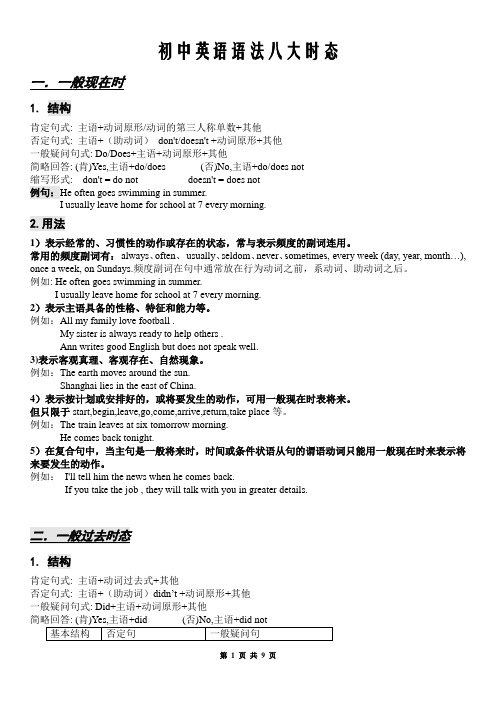
初中英语语法八大时态一.一般现在时1.结构肯定句式: 主语+动词原形/动词的第三人称单数+其他否定句式: 主语+(助动词)don't/doesn't +动词原形+其他一般疑问句式: Do/Does+主语+动词原形+其他简略回答: (肯)Yes,主语+do/does (否)No,主语+do/does not缩写形式: don't = do not doesn't = does not例句:He often goes swimming in summer.I usually leave home for school at 7 every morning.2.用法1)表示经常的、习惯性的动作或存在的状态,常与表示频度的副词连用。
常用的频度副词有:always、often、usually、seldom、never、sometimes, every week (day, year, month…), once a week, on Sundays.频度副词在句中通常放在行为动词之前,系动词、助动词之后。
例如: He often goes swimming in summer.I usually leave home for school at 7 every morning.2)表示主语具备的性格、特征和能力等。
例如:All my family love football .My sister is always ready to help others .Ann writes good English but does not speak well.3)表示客观真理、客观存在、自然现象。
例如:The earth moves around the sun.Shanghai lies in the east of China.4)表示按计划或安排好的,或将要发生的动作,可用一般现在时表将来。
(完整版)初中英语八种基本时态总结

初中英语基本时态总结Ⅰ、一般现在时1、概念:1)表示经常性或习惯性的动作,常与表示频度的时间状语连用。
时间状语:always, usually, often, sometimes, seldom, never, every day, twice a week, on Sunday, etc.(提问用How often)例:I leave home for school at 7 every morning.Tom gets up at 6:00 every morning.2)客观真理,客观存在,科学事实。
例:The earth moves around the sun. 地球绕太阳转动。
Shanghai lies in the east of China. 上海位于中国东部。
3)格言或警句。
例:Pride goes before a fall. 骄者必败。
注意:宾语从句中,即使主句是过去时,从句谓语是客观真理也要用一般现在时。
例:Columbus proved that the earth is round. 哥伦布证实了地球是圆的。
2、结构:表状态S+ am/is/are+ P (句中有实义动词不用be)表动作S+V原+O (若主语是单三人称,谓动加s/es。
)3、句式变化:变疑问,有be把be提到主语前;无be在主语前加do/does,谓动变为原形。
变否定,有be在be后加“not”;无be在主语后加don’t/doesn’t,谓动变为原形。
例:①They are in the classroom. →Are they in the classroom? Yes, they are./No, they aren’t. →They aren’t in the classroom②He often waters the flowers . → Does he often water the flowers?Yes, he does. / No, he doesn’t. →He doesn’t often water the flowersⅡ、一般过去时1、概念:1)表示在确定的过去时间里所发生的动作或存在的状态。
初中英语8大时态整理
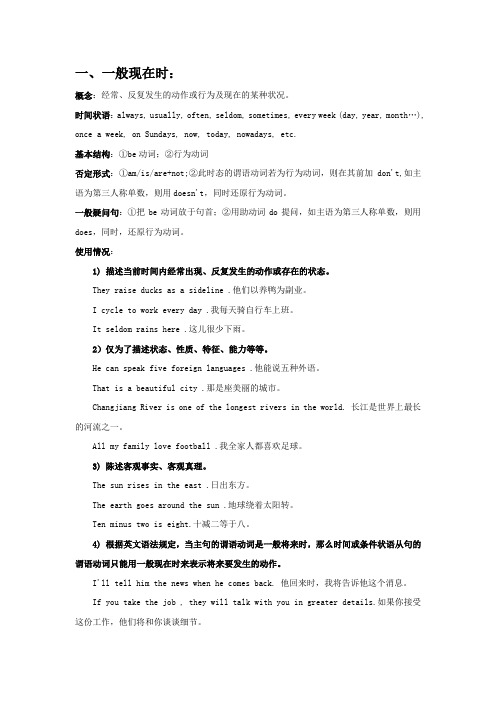
概念:经常、反复发生的动作或行为及现在的某种状况。
时间状语:always, usually, often, seldom, sometimes, every week (day, year, month…), once a week, on Sundays, now, today, nowadays, etc.基本结构:①be动词;②行为动词否定形式:①am/is/are+not;②此时态的谓语动词若为行为动词,则在其前加don't,如主语为第三人称单数,则用doesn't,同时还原行为动词。
一般疑问句:①把be动词放于句首;②用助动词do提问,如主语为第三人称单数,则用does,同时,还原行为动词。
使用情况:1) 描述当前时间内经常出现、反复发生的动作或存在的状态。
They raise ducks as a sideline .他们以养鸭为副业。
I cycle to work every day .我每天骑自行车上班。
It seldom rains here .这儿很少下雨。
2)仅为了描述状态、性质、特征、能力等等。
He can speak five foreign languages .他能说五种外语。
That is a beautiful city .那是座美丽的城市。
Changjiang River is one of the longest rivers in the world. 长江是世界上最长的河流之一。
All my family love football .我全家人都喜欢足球。
3) 陈述客观事实、客观真理。
The sun rises in the east .日出东方。
The earth goes around the sun .地球绕着太阳转。
Ten minus two is eight.十减二等于八。
4) 根据英文语法规定,当主句的谓语动词是一般将来时,那么时间或条件状语从句的谓语动词只能用一般现在时来表示将来要发生的动作。
初中英语8个时态的简要总结
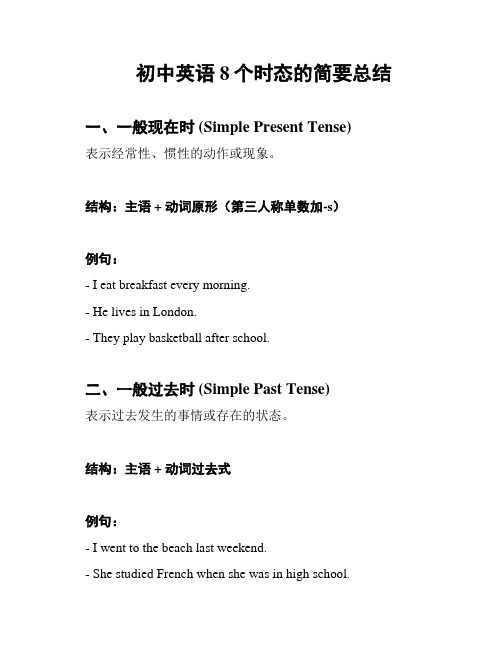
初中英语8个时态的简要总结一、一般现在时 (Simple Present Tense)表示经常性、惯性的动作或现象。
结构:主语 + 动词原形(第三人称单数加-s)例句:- I eat breakfast every morning.- He lives in London.- They play basketball after school.二、一般过去时 (Simple Past Tense)表示过去发生的事情或存在的状态。
结构:主语 + 动词过去式例句:- I went to the beach last weekend.- She studied French when she was in high school.- We played soccer yesterday.三、一般将来时 (Simple Future Tense)表示将要发生的事情或存在的状态。
结构:主语 + will + 动词原形例句:- I will meet my friends tomorrow.- She will travel to Japan next month.- They will study for the exam this weekend.四、现在进行时 (Present Continuous Tense)表示现在正在进行的动作。
结构:主语 + am/is/are + 动词-ing例句:- I am studying for the test.- He is watching TV right now.- They are playing soccer in the park.五、过去进行时 (Past Continuous Tense)表示过去某个时间正在进行的动作。
结构:主语 + was/were + 动词-ing例句:- We were studying when the phone rang.- She was cooking dinner at 6 pm yesterday.- They were walking in the park when it started raining.六、现在完成时 (Present Perfect Tense)表示过去发生的动作对现在造成的影响或关联。
初中英语八种时态归纳
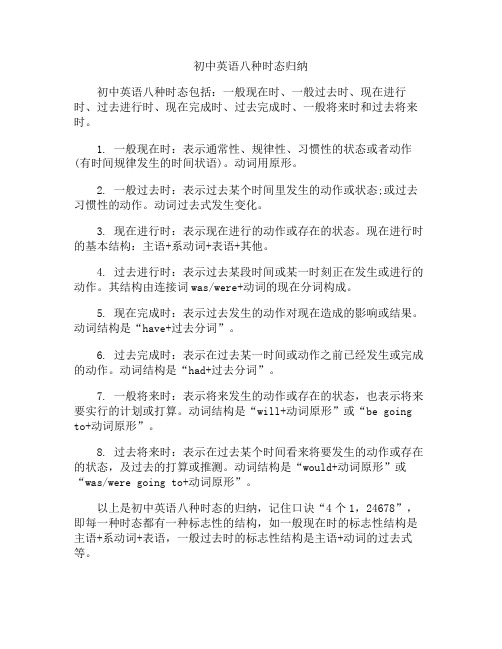
初中英语八种时态归纳
初中英语八种时态包括:一般现在时、一般过去时、现在进行时、过去进行时、现在完成时、过去完成时、一般将来时和过去将来时。
1. 一般现在时:表示通常性、规律性、习惯性的状态或者动作(有时间规律发生的时间状语)。
动词用原形。
2. 一般过去时:表示过去某个时间里发生的动作或状态;或过去习惯性的动作。
动词过去式发生变化。
3. 现在进行时:表示现在进行的动作或存在的状态。
现在进行时的基本结构:主语+系动词+表语+其他。
4. 过去进行时:表示过去某段时间或某一时刻正在发生或进行的动作。
其结构由连接词was/were+动词的现在分词构成。
5. 现在完成时:表示过去发生的动作对现在造成的影响或结果。
动词结构是“have+过去分词”。
6. 过去完成时:表示在过去某一时间或动作之前已经发生或完成的动作。
动词结构是“had+过去分词”。
7. 一般将来时:表示将来发生的动作或存在的状态,也表示将来要实行的计划或打算。
动词结构是“will+动词原形”或“be going to+动词原形”。
8. 过去将来时:表示在过去某个时间看来将要发生的动作或存在的状态,及过去的打算或推测。
动词结构是“would+动词原形”或“was/were going to+动词原形”。
以上是初中英语八种时态的归纳,记住口诀“4个1,24678”,即每一种时态都有一种标志性的结构,如一般现在时的标志性结构是主语+系动词+表语,一般过去时的标志性结构是主语+动词的过去式等。
(最新版)初中英语语法八大时态概述

(最新版)初中英语语法八大时态概述一、现在时态(Present Tense)1. 一般现在时:- 表示经常性、惯性的动作或状态:I play football every Sunday.(我每个星期天都踢足球。
)- 表示客观真理或普遍性事实:The sun rises in the east.(太阳从东方升起。
)2. 现在进行时:- 表示正在进行的动作:She is reading a book.(她正在看一本书。
)- 表示近期安排或打算:We are going to the movies tomorrow.(我们明天要去看电影。
)二、过去时态(Past Tense)1. 一般过去时:- 表示过去某个时间发生的动作或状态:He visited his grandparents last week.(他上周去看望了他的祖父母。
)2. 过去进行时:- 表示过去某一时刻正在进行的动作:I was studying when she called me.(她给我打电话的时候,我正在研究。
)三、将来时态(Future Tense)1. 一般将来时:- 表示将来某个时间将要发生的动作或状态:I will visit my friend next week.(我下周要去拜访我的朋友。
)2. 将来进行时:- 表示将来某一时刻正在进行的动作:They will be having dinner when we arrive.(当我们到达的时候,他们正在吃晚饭。
)四、现在完成时态(Present Perfect Tense)- 表示过去某个时间开始并一直延续到现在的动作或状态:I have lived here for 10 years.(我已经在这里住了10年了。
)五、过去完成时态(Past Perfect Tense)- 表示过去某个时间之前已经完成的动作或状态:She had already left when I arrived.(当我到达时,她已经离开了。
初中英语语法八大时态总结

1.一般现在时2 .一般过去时3 .一般将来时4 .现在进行时5 .过去进行时6 .现在完成时7 .过去完成时8 .过去将来时1.一般现在时1.一般现在时的构成一般现在时主要用动词原形表示,如果主语是第三人称单数则动词也要用第三人称单数形式。
动词第三人称单数的构成方式如下:构成方法例词一般在词尾加-s work—works;spend—spends在以s,z,ch,sh,x等字母结尾的动词之后加-es pass—passes;wash—washes;teach—teaches;mix—mixes以不发音的e结尾的动词只在e后加-s write—writes;ride—rides 以“辅音字母+y”结尾的动词,变y为i,再加-esstudy—studies;try—tries 以o结尾的动词,在词尾加-es do—does;go—goes2.一般现在时的用法(1)表示经常性或习惯性的动作或存在的状态,常与often,always,usually,sometimes,once a week,every day/...等表示频率的副词或时间状语连用。
如:I often go to school by bike.我经常骑车去上学。
(2)表示客观事实或普遍真理。
如:The earth goes around the sun.地球绕着太阳转。
(3)在时间、条件等状语从句中,用一般现在时表示将来。
如:If it rains tomorrow,we won't go to the park.如果明天下雨,我们将不去公园。
When I grow up,I will go to America.当我长大后,我将去美国。
即学即练( )1.If Nancy ________ the exam ,she will go to Australia for English study.A .passB .passedC .passesD .will pass ( )2.The Greens will visit Hainan as soon as they ________ to China.A .comesB .comeC .cameD .will come ( )3.Now my father ________ his bike to work every day instead of driv ing.A .rideB .rodeC .ridesD .will rideC B C2.一般过去时1.一般过去时的构成一般过去时用动词的过去式表示,即:主语+动词的过去式。
- 1、下载文档前请自行甄别文档内容的完整性,平台不提供额外的编辑、内容补充、找答案等附加服务。
- 2、"仅部分预览"的文档,不可在线预览部分如存在完整性等问题,可反馈申请退款(可完整预览的文档不适用该条件!)。
- 3、如文档侵犯您的权益,请联系客服反馈,我们会尽快为您处理(人工客服工作时间:9:00-18:30)。
初中英语八大时态知识梳理一、一般现在时:基本结构:①动词原形②主语三单:动词原形+s/es三种常考基本用法:1.经常性和习惯性动作:I always get up early.2.客观事实和普遍真理:The earth goes around the sun.3.在时间状语从句及条件状语从句中,一般现在表将来:If it doesn't rain, we will have a picnic.I’ll call you when I arrive at the airport.该用法遵循"主将从现"的原则。
常见时间状语:always, usually, often, sometimes, every day, on Sundays, at weekends, once a week, twice a month, etc.二、一般过去时:基本结构:动词的过去式基本用法:1、过去某个时间里发生的动作或状态e.g. I got up late yesterday.2、过去习惯性、经常性的动作Eg. When I was in the countryside, I often swam in the river.常见时间状语:ago, yesterday, the day before yesterday, last week (year, night, month…), in 1986, just now, at the age of 10, at that time, once u pon a time, etc.三、一般将来时:基本结构:①am/is/are/going to + do;②will/shall + do.基本用法:am/is/are/going to + do1、(人)计划打算做某事Eg. I'm going to go shopping with my mom tomorrow.2、(事)即将发生Eg. Look at the clouds, it's going to rain.will/shall do1、将来的动作和状态(相对较长远)Eg. You'll have your own house in the future.2、礼貌询问、客气邀请Eg. Will you go with me?3、意愿Eg. I will do it for you.常见时间状语:tomorrow, next day (week, month, year…), soon, the day after tomorrow, in+时间段(格外注意),etc.四、现在进行时:基本结构:am/is/are+现在分词基本用法:1、此时此刻正在进行的动作Eg. I am writing a letter now.2、现阶段正在进行的动作Eg. I am reading a book these days.常见时间状语:now, at this time, these days, etc.五、过去进行时:基本结构:was/were+现在分词基本用法:1、过去某时刻正在进行的动作Eg. He was playing computer games when his father came home.2、过去某时段正在进行的动作Eg. He was doing his homework while his mother was cooking.常见时间状语:at this time yesterday, at that time或以when引导的谓语动词是一般过去时的时间状语等。
六、过去将来时:基本结构:①was/were/going to + do;②would/should + do.基本用法:从过去时间点看将来,常用于宾语从句中。
Eg. He said that he would marry her.常见时间状语:the next day (morning, year…), the following month (week…), etc.七、现在完成时:基本结构:have/has + 过去分词基本用法:1.过去发生的动作对现在造成的影响或结果(已经完成的动作,但动作造成的影响还在),常被just,already,yet 等副词修饰。
如:He has already gone to Tianjin.(对现在造成的影响是他已经不在这儿了)。
2.现在完成时还可用来表示过去发生的动作一直延续到现在,常带有for或since等表示一段时间的状语。
如:Mr Wang has lived here since 1983.3.表示说话前发生过一次或多次的动作,我们常用"过"来表示,常带有twice,once, ever, never等时间状语。
如:I've never seen that film.常见时间状语:recently, lately, so far, up to now, since+时间点,for+时间段, in the past few years, etc.八、过去完成时:基本结构:had + 过去分词基本用法:以过去某个时间为标准,在此以前发生的动作或行为,即"过去的过去"。
Eg. Just before the English class, I suddenly realized that I had left my English textbook at home.常见时间状语:before, after, by the end of last year(month…),etc.1.一般现在时:常与always,often,sometimes, every day连用,表示习惯或经常反复发生的动作或存在的状态。
提醒你当第三人称单数做主语时,别忘了动词的变化。
注意:像"地球大,月亮小"等客观真理、事实一定用一般现在时。
2.现在进行时:要注意其构成:由be+动词+ing,表示说话时正在进行的动作。
如:We're studying now. 我们现在正在学习。
3.一般过去时:表示过去某个时间发生的动作或存在的状态,常与yesterday,lastyear,in 1949,two years ago,等表示过去时间的状语连用。
注意:We often went to dance last summer.有的同学一见到often就想到用一般现在时,其实因为后面有表示过去时间的last summer, 所以要用过去式,千万别误用了,切记,切记。
4.过去进行时:显然过去进行时表示过去某一时刻正在做什么,常和特定的时间状语如at that time,at six yesterday,at that moment,when he came in 等连用。
如:When he knocked at the door, his mother was cooking.5.一般将来时:表示将要发生的动作或存在的状态,常与表示将来时间状语如next year, tomorrow等连用。
注意:在Will you ....?问句中,回答必须是Yes,I will.或No,I won't6.现在完成时:顾名思义,现在完成时表示的是已经完成的动作,但动作造成的影响还在,常被just,already,yet 等副词修饰。
如:He has already gone to Tianjin. 对现在造成的影响是他已经不在这儿了。
现在完成时还可用来表示过去发生的动作一直延续到现在,常带有for或since等表示一段时间的状语。
如:Mr Wang has lived here since 1983.表示说话前发生过一次或多次的动作,我们常用"过"来表示,常带有twice, once, ever, never等时间状语。
如:I've never seen that film.7.过去完成时:我们可以用"过去的过去"来概括过去完成时,表示过去某一时刻或某一动作之前已经完成了的动作,通常与by,before等构成的短语或when, before, after引导的从句连用。
也可表示过去某一时间开始,一直延续到过去另一时间的动作,常和for或since构成的时间状语连用。
用法和现在完成时大致相同,只不过又向前推了一个时态。
时态区分一般过去式和现在完成时:一般过去式只是表示事情发生在过去,陈述一个事实,它可以和确定的表示过去的时间状语如:last night, in 1999, three days ago等连用。
而现在完成时表示某一完成的动作对现在造成的影响或结果,强调的是现在的情况,所以它不能和确定的表示过去的时间状语连用。
如: We have seen that film. 我们已看过那部电影。
对现在造成的影响是我们对影片已有所了解。
We saw the film last night. 昨天晚上我们看了那部电影。
只说明昨天晚上看电影这一事实。
注意:有些时间状语,如this morning,tonight, this month 等,既可用于一般过去时,又可用于现在完成时,但所表达的意义有所不同。
用于现在完成时表示包括现在在内,而用于一般过去式则与现在无关。
如: I have read this book thisApril.(说话时仍然为四月。
) I read this book this April. (说话时四月份已过。
)一般过去式和过去完成时的比较:一般过去式表示过去时间发生的动作或存在的状态,而过去完成时在过去某一时间或动作之前已完成的动作或状态,即"过去的过去"。
当强调过去某一动作发生在某一动作之前时,常用此时态。
如: He had finished his homework before nine o'clock. 九点之前他已经完成了作业。
实际上,一般现在时和过去完成时常搭配使用。
如: When he got home, his daughter had already gone to bed. 当他到家的时候,他的女儿早已去睡觉了。
在带有after和before引导的时间状语从句的复合句中,由于从句的动作和主句的动作发生的先后顺序已经非常明确,所以可以用一般过去时代替过去完成时。
如:He called on me soon after he had finished his homework. 他做完作业后不久便来拜访我。
